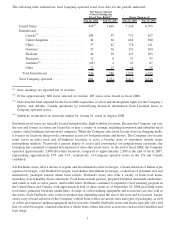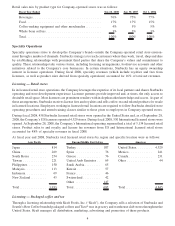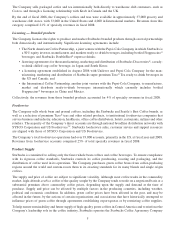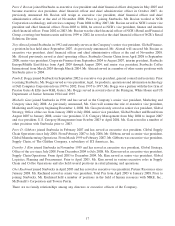Starbucks 2008 Annual Report Download - page 19
Download and view the complete annual report
Please find page 19 of the 2008 Starbucks annual report below. You can navigate through the pages in the report by either clicking on the pages listed below, or by using the keyword search tool below to find specific information within the annual report.consistency with the Company’s goals, philosophy and standards. Significant growth can make it increasingly
difficult to ensure a consistent supply of high quality raw materials, to locate and hire sufficient numbers of key
employees to meet the Company’s financial targets, to maintain an effective system of internal controls for a
globally dispersed enterprise and to train employees worldwide to deliver a consistently high quality product and
customer experience.
•Adverse public or medical opinions about the health effects of consuming the Company’s products, as well
as reports of incidents involving food-borne illnesses or food tampering, whether or not accurate, could
harm its business.
Some Starbucks products contain caffeine, dairy products, sugar and other active compounds, the health effects of
which are the subject of increasing public scrutiny, including the suggestion that excessive consumption of caffeine,
dairy products, sugar and other active compounds can lead to a variety of adverse health effects. There has also been
greater public awareness that sedentary lifestyles, combined with excessive consumption of high-calorie foods,
have led to a rapidly rising rate of obesity. Particularly in the United States, there is increasing consumer awareness
of health risks, including obesity, due in part to increasing publicity and attention from health organizations, as well
as increased consumer litigation based on alleged adverse health impacts of consumption of various food products.
While Starbucks has a variety of healthy choice beverage and food items, including items that are low in caffeine
and calories, an unfavorable report on the health effects of caffeine or other compounds present in the Company’s
products, or negative publicity or litigation arising from other health risks such as obesity, could significantly reduce
the demand for the Company’s beverages and food products.
Similarly, instances or reports, whether true or not, of unclean water supply, food-borne illnesses and food
tampering have in the past severely injured the reputations of companies in the food processing, grocery and quick-
service restaurant sectors and could in the future affect the Company as well. Any report linking Starbucks to the use
of unclean water, food-borne illnesses or food tampering could damage its brand value, immediately and severely
hurt sales of its beverages and food products, and possibly lead to product liability claims. Clean water is critical to
the preparation of specialty coffee beverages. The Company’s ability to ensure a clean water supply to its stores is
limited, particularly in some International locations. If customers become ill from food-borne illnesses, the
Company could also be forced to temporarily close some stores. In addition, instances of food-borne illnesses or
food tampering, even those occurring solely at the restaurants or stores of competitors, could, by resulting in
negative publicity about the foodservice industry, adversely affect Starbucks sales on a regional or global basis. A
decrease in customer traffic as a result of these health concerns or negative publicity, or as a result of a temporary
closure of any of the Company’s stores, could materially harm the Company’s business and results of operations.
•A regional or global health pandemic could severely affect Starbucks business.
A health pandemic is a disease that spreads rapidly and widely by infection and affects many individuals in an area
or population at the same time. If a regional or global health pandemic were to occur, depending upon its duration
and severity, the Company’s business could be severely affected. Starbucks has positioned itself as a third place
between home and work where people can gather together for human connection. Customers might avoid public
gathering places in the event of a health pandemic, and local, regional or national governments might limit or ban
public gatherings to halt or delay the spread of disease. A regional or global health pandemic might also adversely
impact the Company’s business by disrupting or delaying production and delivery of materials and products in its
supply chain and by causing staffing shortages in its stores. The impact of a health pandemic on Starbucks might be
disproportionately greater than on other companies that depend less on the gathering of people together for the sale,
use or license of their products and services.
•Increased leverage and/or increases in interest rates may harm the Company’s financial condition and
results of operations.
As of September 28, 2008, Starbucks had approximately $5.1 billion in minimum future rental payments under non-
cancelable operating leases and $3.2 billion of total liabilities on a consolidated basis. Included in total liabilities are
aggregate principal indebtedness of $713 million under outstanding commercial paper and revolving credit facility
borrowings, and $550 million under ten-year notes maturing in August 2017. Future increases in the Company’s
13
























